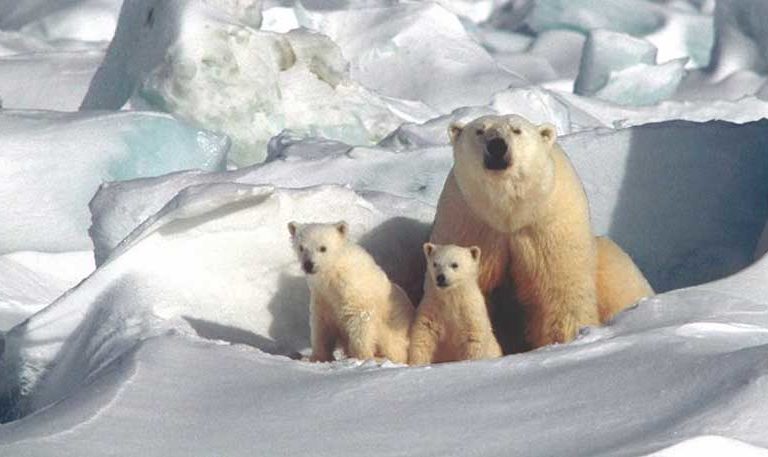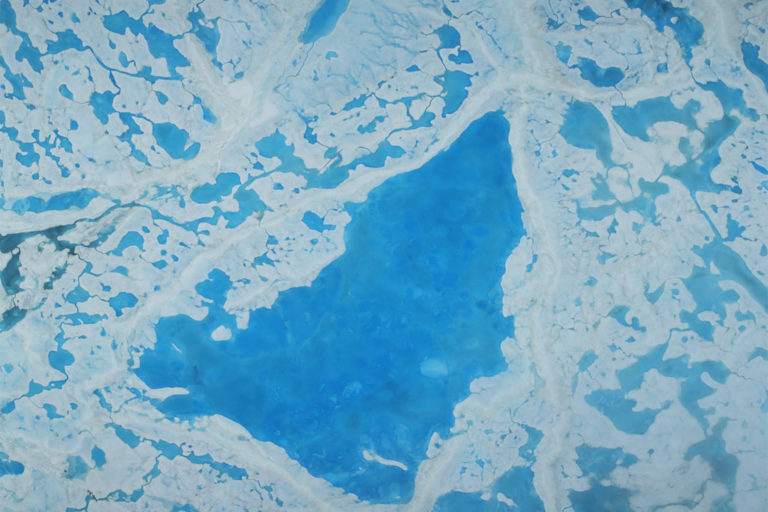
- Low sea ice concentration can create a misleading picture of sea ice health in the Arctic. Though extent is only at its 12th lowest since satellite records began in 1979, the waters north of Alaska this September are full of diffuse ice.
- Of great concern to scientists, the Arctic has lost 95% of its thick multiyear sea ice since 1985. Older, thicker ice acts as a buffer against future Blue Ocean Events, expected as early as 2035. A BOE would mark a year when most Arctic ice melts out in summer.
- It no longer takes a freak-weather year to reach near record-lows for extent or volume. 2020 saw a second-place finish in the record book, behind 2012.
Early in July, Arctic sea ice seemed primed to set a new record at the annual minimum — the date in September when ice floating atop the ocean reaches its lowest extent. For weeks, the sea ice had been tracking in line with the past record low years of 2020 and 2012. But then as cool, cloudy weather came to dominate the Arctic in early August, ice loss stalled and the region managed to avoid a calamitous year for sea ice cover. In fact, as of September 16, extent was at its 10th lowest on record, tracking above the last six years, covering 4.724 million square kilometers (1.824 million square miles).
“We’re looking at a reprieve this year,” says Mark Serreze, executive director of the National Snow and Ice Data Center (NSIDC)
However, looks can be deceiving. The volume and concentration of sea ice, as well as the presence of multiyear ice — that is, older ice often between two and four meters thick — tell a different and worrying story. The big news: multiyear ice is at a record low in 2021, and it is likely volume is down too, though that data has yet to be fully analyzed.
The reason for the disparity between extent, volume and concentration: Although sea ice may be widely spread out, covering a vast surface area this September, that ice is unusually thin and fragmented. “The health of the ice cover is not good,” notes Serreze.

Ice concentration is down
Scientists measure ice extent by breaking up the ocean into gridded cells, each covering an area of 625 square kilometers (241.3 square miles), and analyzing pixels in satellite images to determine which cells contain ice. Any cell including more than 15% ice is counted as being solid with ‘ice,’ while any cell below 15% is considered to contain ‘no ice.’ Importantly, this averaging doesn’t differentiate between 20% ice cover and, say, 90%. This means that even when sea ice extent within a grid cell exists in very low concentrations, it will still be counted in the same category as higher concentrations. Extent, therefore, isn’t indicative of ice quality — with solid ice, and ice riddled with holes resembling Swiss cheese, often rated as equivalent.
“It’s a little misleading,” agrees Serreze. “A lot of these pixels are counted as ice, but they don’t have a lot of ice — maybe 30 or 40 percent. It’s very diffuse ice in areas north of Alaska’s Beaufort Sea and in the Chukchi Sea this year.”
Though sea ice in the western Arctic appeared more extensive this summer, the same could not be said for the Laptev Sea and East Greenland Sea, both bordering Siberia . The “Laptev Sea is just wide open and it happened very early,” says Serreze.” While the melt season began about two to three weeks later than average in the northern Beaufort Sea, ice retreat began more than a month early in the Laptev north of Russia, and ultimately reached an all-time low in the satellite record.
Meanwhile, ice in the East Greenland Sea hovers just below a record low set in 2002. Open water also surprisingly persists in the Wandel Sea (stretching from northeast Greenland to Svalbard) — rare for that region home to multiyear ice until recent years. Overall, the start of the melt season across the Arctic was five days earlier than average in 2021.
In summary, “the [Arctic sea ice] extent is higher than in recent years, but that is not telling the full story,” says Serreze.

Arctic sea ice getting younger
The most worrying headline this September is the lack of multiyear ice in Arctic waters. Multiyear ice is ice that persists during the summer melting season, typically growing thicker, rougher and more melt-resistant as the years pass. Ecosystems, animals, and people depend on this old ice, which has also long aided in preventing a so-called Blue Ocean Event or BOE — a future year in which nearly all Arctic ice melts, expected to occur later this century, though models disagree as to precisely when.
Multiyear ice has been on a downward trend for nearly four decades, and that trend continued this year. Scientists calculated that multiyear ice made up 16% of the total sea ice pack in 1985. Today, that has dropped to just 1% — a 95% loss of thick resilient ice over a mere 36 years.
2021 is especially bad. At the start of August, multiyear ice covered just 1.6 million square kilometers (618,000 square miles).
“Although multiyear ice is more resilient than younger ice, this year we saw a lot of older ice thrust into regions where ice normally melts,” explains Robbie Mallett, who studies sea ice and is a PhD candidate at University College London.

To survive, multiyear sea ice needs to stay in the cooler waters of the High North. But in the winter of 2020, the polar vortex — a ring of counterclockwise wind that typically holds extremely cold air in place over the Arctic — collapsed, creating an unusual pattern of clockwise surface winds that spun around the center of the Arctic, pushing the multiyear ice pack north of Greenland out into the warmer Beaufort Sea.
For months, thick, old ice flowed into the Beaufort Sea until it contained nearly a quarter of the Arctic Ocean’s multiyear ice. “The question [then] was, ‘Is all that ice going to melt out in the coming summer?’” says NSIDC’s Serreze. “And, this summer, because it’s so warm in the Beaufort, the answer appears to be that most of it melted out.”
“Historically, we haven’t lost large amounts of multiyear ice to being blown into the Beaufort,” Mallett reports. “We often see ice leaving through the Fram Strait which goes into the North Atlantic [between Greenland and Svalbard].”

The loss of multiyear ice has many repercussions for the Arctic ecosystem — and potentially for the global climate. Because it’s thicker, it reduces the amount of light that penetrates Arctic waters, thus dictating the productivity of primary producers, like algae, growing on the ice. These primary producers influence the rest of the Arctic food web.
Multiyear ice also serves as a buffer against a warming Arctic atmosphere and ocean, protecting the rest of the sea ice and helping stave off a Blue Ocean Event. No one knows precisely how the global climate will respond to a BOE, or a succession of BOE’s, when the dark waters of an open Arctic Ocean begin absorbing and holding much more of the sun’s summer heat, rather than reflecting it back to space as the region’s ice does today.
The only silver lining, Mallett says, is that he expected more multiyear ice would melt out this summer. “But because it’s not been a very [hot or sunny] summer for the Arctic, that’s contributed to its survival.”

Still, the overall trend is alarming to researchers. “Last year we had the second lowest extent on record. I think it’s important to remember that if you view the Arctic on a linear trend, that wasn’t a freak year like 2007 or 2012,” says Mallett. In other words, even though low extent didn’t occur this year, losses in Arctic ice — reductions in multiyear ice, extent, volume, and concentration — are to be expected in the future unless humanity drastically reduces its annual atmospheric carbon emissions.
The next critical date for assuring these carbon reductions comes in early November when representatives of the world’s nations gather in Glasgow Scotland for the COP26 summit at which negotiators will try to put mechanisms permanently in place to keep a temperature rise of 1.5 degrees Celsius within reach, hopefully preventing catastrophic climate change.
Citations:
Mallett, R. D. C., Stroeve, J. C., Cornish, S. B. et al. (2021). Record winter winds in 2020/21 drove exceptional Arctic sea ice transport. Communications Earth & Environment, 2(1). https://doi.org/10.1038/s43247-021-00221-8
Banner image:A mother polar bear and her cubs. Image courtesy of the U.S. Geological Survey, CC PDM 1.0
FEEDBACK: Use this form to send a message to the author of this post. If you want to post a public comment, you can do that at the bottom of the page.
Researchers express alarm as Arctic multiyear sea ice hits record low
Source: Trends News

0 Comments